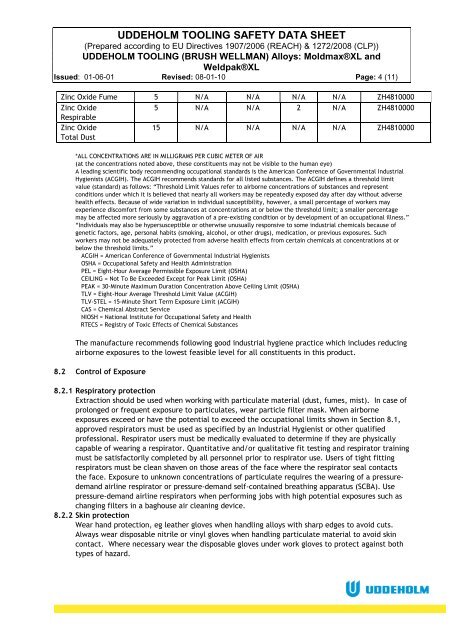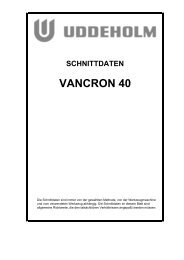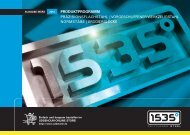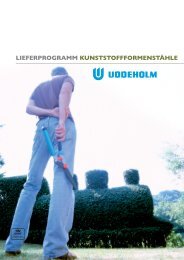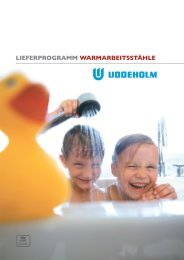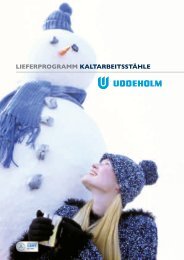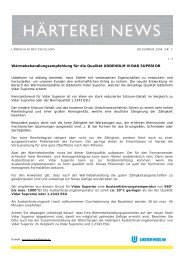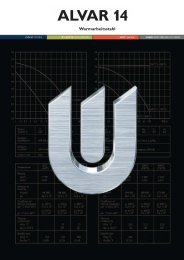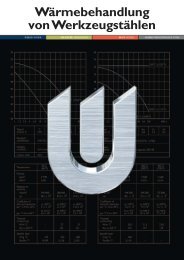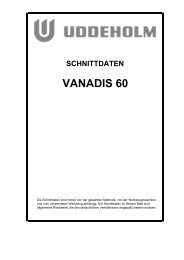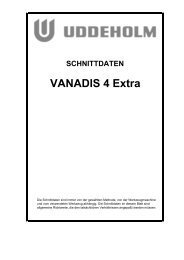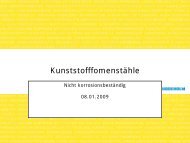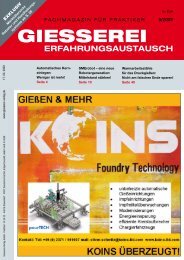Moldmax XL, Weldpak XL
Moldmax XL, Weldpak XL
Moldmax XL, Weldpak XL
Create successful ePaper yourself
Turn your PDF publications into a flip-book with our unique Google optimized e-Paper software.
UDDEHOLM TOOLING SAFETY DATA SHEET<br />
(Prepared according to EU Directives 1907/2006 (REACH) & 1272/2008 (CLP))<br />
UDDEHOLM TOOLING (BRUSH WELLMAN) Alloys: <strong>Moldmax</strong>®<strong>XL</strong> and<br />
<strong>Weldpak</strong>®<strong>XL</strong><br />
Issued: 01-06-01 Revised: 08-01-10 Page: 4 (11)<br />
Zinc Oxide Fume 5 N/A N/A N/A N/A ZH4810000<br />
Zinc Oxide<br />
5 N/A N/A 2 N/A ZH4810000<br />
Respirable<br />
Zinc Oxide<br />
Total Dust<br />
15 N/A N/A N/A N/A ZH4810000<br />
*ALL CONCENTRATIONS ARE IN MILLIGRAMS PER CUBIC METER OF AIR<br />
(at the concentrations noted above, these constituents may not be visible to the human eye)<br />
A leading scientific body recommending occupational standards is the American Conference of Governmental Industrial<br />
Hygienists (ACGIH). The ACGIH recommends standards for all listed substances. The ACGIH defines a threshold limit<br />
value (standard) as follows: “Threshold Limit Values refer to airborne concentrations of substances and represent<br />
conditions under which it is believed that nearly all workers may be repeatedly exposed day after day without adverse<br />
health effects. Because of wide variation in individual susceptibility, however, a small percentage of workers may<br />
experience discomfort from some substances at concentrations at or below the threshold limit; a smaller percentage<br />
may be affected more seriously by aggravation of a pre-existing condition or by development of an occupational illness.”<br />
“Individuals may also be hypersusceptible or otherwise unusually responsive to some industrial chemicals because of<br />
genetic factors, age, personal habits (smoking, alcohol, or other drugs), medication, or previous exposures. Such<br />
workers may not be adequately protected from adverse health effects from certain chemicals at concentrations at or<br />
below the threshold limits.”<br />
ACGIH = American Conference of Governmental Industrial Hygienists<br />
OSHA = Occupational Safety and Health Administration<br />
PEL = Eight-Hour Average Permissible Exposure Limit (OSHA)<br />
CEILING = Not To Be Exceeded Except for Peak Limit (OSHA)<br />
PEAK = 30-Minute Maximum Duration Concentration Above Ceiling Limit (OSHA)<br />
TLV = Eight-Hour Average Threshold Limit Value (ACGIH)<br />
TLV-STEL = 15-Minute Short Term Exposure Limit (ACGIH)<br />
CAS = Chemical Abstract Service<br />
NIOSH = National Institute for Occupational Safety and Health<br />
RTECS = Registry of Toxic Effects of Chemical Substances<br />
The manufacture recommends following good industrial hygiene practice which includes reducing<br />
airborne exposures to the lowest feasible level for all constituents in this product.<br />
8.2 Control of Exposure<br />
8.2.1 Respiratory protection<br />
Extraction should be used when working with particulate material (dust, fumes, mist). In case of<br />
prolonged or frequent exposure to particulates, wear particle filter mask. When airborne<br />
exposures exceed or have the potential to exceed the occupational limits shown in Section 8.1,<br />
approved respirators must be used as specified by an Industrial Hygienist or other qualified<br />
professional. Respirator users must be medically evaluated to determine if they are physically<br />
capable of wearing a respirator. Quantitative and/or qualitative fit testing and respirator training<br />
must be satisfactorily completed by all personnel prior to respirator use. Users of tight fitting<br />
respirators must be clean shaven on those areas of the face where the respirator seal contacts<br />
the face. Exposure to unknown concentrations of particulate requires the wearing of a pressuredemand<br />
airline respirator or pressure-demand self-contained breathing apparatus (SCBA). Use<br />
pressure-demand airline respirators when performing jobs with high potential exposures such as<br />
changing filters in a baghouse air cleaning device.<br />
8.2.2 Skin protection<br />
Wear hand protection, eg leather gloves when handling alloys with sharp edges to avoid cuts.<br />
Always wear disposable nitrile or vinyl gloves when handling particulate material to avoid skin<br />
contact. Where necessary wear the disposable gloves under work gloves to protect against both<br />
types of hazard.


